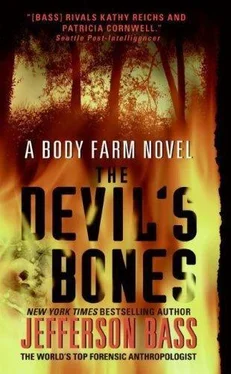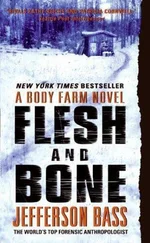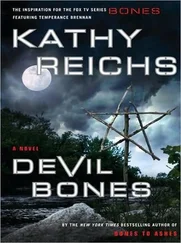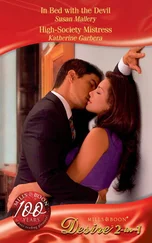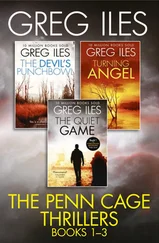Jefferson Bass - The Devil's Bones
Здесь есть возможность читать онлайн «Jefferson Bass - The Devil's Bones» весь текст электронной книги совершенно бесплатно (целиком полную версию без сокращений). В некоторых случаях можно слушать аудио, скачать через торрент в формате fb2 и присутствует краткое содержание. Год выпуска: 2009, Жанр: Детектив, на английском языке. Описание произведения, (предисловие) а так же отзывы посетителей доступны на портале библиотеки ЛибКат.
- Название:The Devil's Bones
- Автор:
- Жанр:
- Год:2009
- ISBN:нет данных
- Рейтинг книги:4 / 5. Голосов: 1
-
Избранное:Добавить в избранное
- Отзывы:
-
Ваша оценка:
- 80
- 1
- 2
- 3
- 4
- 5
The Devil's Bones: краткое содержание, описание и аннотация
Предлагаем к чтению аннотацию, описание, краткое содержание или предисловие (зависит от того, что написал сам автор книги «The Devil's Bones»). Если вы не нашли необходимую информацию о книге — напишите в комментариях, мы постараемся отыскать её.
The Devil's Bones — читать онлайн бесплатно полную книгу (весь текст) целиком
Ниже представлен текст книги, разбитый по страницам. Система сохранения места последней прочитанной страницы, позволяет с удобством читать онлайн бесплатно книгу «The Devil's Bones», без необходимости каждый раз заново искать на чём Вы остановились. Поставьте закладку, и сможете в любой момент перейти на страницу, на которой закончили чтение.
Интервал:
Закладка:
I felt my way into the living room, where an oil lamp-its glass chimney and base grimy to the touch-occupied a dusty spot on the mantel. Lifting the chimney free of the metal clips that held it in place, I set it on the mantel beside the base, then slid open the matchbox and removed one of the square wooden matches. I pressed the tip lightly against the surface of a brick above the mantel, then dragged the match upward. As it scratched across the rough surface, it gave off a small shower of sparks, then bloomed into a dazzling flower of yellow and blue. Once the flame shrank to a small teardrop of yellow, I touched it to the lamp’s wick, which took the flame and amplified it.
I tucked the box of matches into my pocket and buttoned the flap closed, then wiggled the lamp’s chimney back into position and lifted the lamp from the mantel by the narrow glass neck. Holding it aloft before me, like the Statue of Liberty-the Statue of Electrical Outage, actually, or the Statue of Paranoia-I made my way back to the kitchen and set the lamp on the table. The kitchen had always felt safer, somehow, or more comforting than any other room in the house, but tonight even the kitchen seemed perilous.
Leaves clawed and slapped at the windows like hands-like Garland Hamilton’s hands, slapping me in the face, again and again. Another flash split the darkness, and for a blinding moment I thought I saw a man silhouetted against the lashing rain and shuddering hedge. Then the night went black again, and the afterimage on my retina reversed to a negative: The dark figure looming against the brilliant background lingered as a ghostly shape in white on a field of black, the edges fringed by the bleached-bone fingers of tree branches. When the afterimage faded and my eyes returned to normal, all I could see was my own image reflected in the kitchen window, the oil lamp beneath and to one side of me, casting ominous shadows in the hollows of my eye sockets. I did not look like someone I’d want to meet in a dark alley.
I sat down at the table, close to the lamp, and tilted and angled my head to dispel the shadows around my eyes. Finally satisfied that the sinister expression was gone, I turned my gaze to the lamp itself. Its cotton wick nestled just below a slit in a small metal dome; a small hexagonal knob extended from the dome on a spindly shaft, and by twisting the knob I could roll the wick up or down with gears that were hidden within the dome. Twisting the wick slowly down, I watched it gradually disappear, like sand edging downward into the neck of an hourglass as time begins to run out. As the wick’s edge threatened to vanish through the small metal sleeve between the reservoir of oil and the glass chimney, the flame shrank to a pale blue flicker along the charred edge of woven cotton. I twisted the knob in the other direction, and the wick slowly rose, the flame blooming bright yellow again, its edge as sharp and solid as the edge of a full moon. How is it, I wondered, that something as nebulous as burning oil can look so solid? Why isn’t it ragged and flickering, like the flames of a fireplace or campfire? Why is there no fuzzy transition from glow to not-glow? And why can’t my own life feel so well defined, so neatly edged, anymore?
I lifted the oil lamp by its narrow neck, where the metal collar and wick mechanism screwed onto the glass base. Halfway up the base, at its widest part, oil sloshed within the clear container. The wick-a flat ribbon of woven white cotton-undulated within the liquid, like a tapeworm preserved in alcohol. The lamp’s neck felt small and vulnerable in my grasp, and I forced myself to ease the tension in my grip, lest it snap in my hand, sending the glass base and its flammable contents crashing onto the kitchen’s tile floor. I made my way through the house by lamplight, like some restless ghost from a campfire story, checking each outside door to be sure it was dead-bolted. Then I went into my bedroom, locked the door, and sat in my bed, my back against the headboard. I set the oil lamp on the nightstand beside me, scooting its useless electric companion to the far edge to make room. Then I slid open the nightstand drawer and took out the handgun Steve Morgan had loaned me. I studied it-the tiny blue-black pyramids machined into the grip, the matter-of-fact words and numbers etched into the barrel, the small, precise button of the safety, which I clicked back and forth, off and on, in a hypnotic pattern that was nearly as regular as the ticking of a clock.
I told time that way until a pale gray light seeped through the window, gradually erasing the reflection of the lamp’s glow, replacing it with the shapes of raindrops and bits of shredded leaves on the outside of the panes.
CHAPTER 33
THE ANTHROPOLOGY DEPARTMENT WAS LOCKED ANDdark when I arrived-not surprising at eight o’clock on a summer Sunday morning. Without bothering to shower or even change my rumpled clothes, I had eased my truck down the narrow service drive that ringed the base of the stadium, parking at the foot of the stairs beside the bone lab. Once inside, I flipped on the fluorescent lights overhead, then impulsively flipped them off again. Enough light filtered between the stadium’s girders and through the grimy windows to guide me across the lab, and for what I needed to do, semidarkness was better than the glare of the fluorescents.
The slide sorter was still plugged in, and the cranial X-ray of Freddie Parnell still lay atop the frosted glass. I switched on the light, and the homeless man’s ghostly skull lit up. I studied the overall contours awhile, then focused on the scalloped edges of the frontal sinus. The contours resembled a coastline, but it was an unknown country I was trying to steer toward. Retrieving the tray of cranial fragments from the Cooke County fire scene, I sighed in despair. It wasn’t a matter of simple navigation; what I had to do-what Miranda had been struggling for days to do-was reassemble a second map, the map of tiny, charred bits we’d plucked from the smoldering ruins of the cabin. If we couldn’t piece together more of that second map, we’d never be able to tell whether its landmarks matched Parnell’s or not.
I flipped the X-ray, so I was looking at the frontal sinus from the back-from the inside of Parnell’s skull, in effect-and then laid the two fragments Miranda had painstakingly reassembled just below the image of the sinus, with their curved inner surfaces facing up. Framed by the openings of the stadium’s steelwork, the daylight was spilling through the windows at a low angle, an angle that highlighted the contours of the cavities in the blackened bone. Staring first at one fragment, then at the other, I rotated and angled the bits in almost microscopically small shifts, my eyes darting from the bone to the X-ray and back again with each subtle movement. You’d think it would be easy to tell if a half-inch stretch of bone corresponded to some portion of a two-inch image, but it was maddening. Instead of a coastal map, I decided, what I was working with was a thousand-piece jigsaw puzzle depicting an overcast sky. I was trying to match one tiny detail to the image on the cover of the puzzle box-that’s what the X-ray was like-without actually knowing that this puzzle had indeed come out of that box.
After half an hour of this, my eyes were playing tricks on me. I didn’t think the fragments matched the X-ray, but then again, I didn’t want them to match. I wanted this to be the skull of Garland Hamilton, not some down-on-his-luck derelict. In any other forensic case, I’d have been able to compare the sinuses with scientific rigor and objectivity-I wouldn’t have anything personal invested in whether the comparison yielded a positive identification, a positive exclusion, or insufficient information to support either conclusion. Go with the facts, speak the truth, and let the chips fall where they may-that had always been one of my guiding principles. But never before had the chips come solely from the pockets of my own life. What’s more, the facts here were proving mighty hard to pin down.
Читать дальшеИнтервал:
Закладка:
Похожие книги на «The Devil's Bones»
Представляем Вашему вниманию похожие книги на «The Devil's Bones» списком для выбора. Мы отобрали схожую по названию и смыслу литературу в надежде предоставить читателям больше вариантов отыскать новые, интересные, ещё непрочитанные произведения.
Обсуждение, отзывы о книге «The Devil's Bones» и просто собственные мнения читателей. Оставьте ваши комментарии, напишите, что Вы думаете о произведении, его смысле или главных героях. Укажите что конкретно понравилось, а что нет, и почему Вы так считаете.
